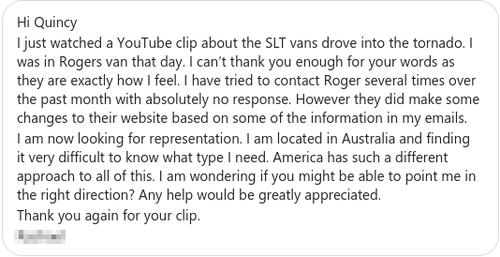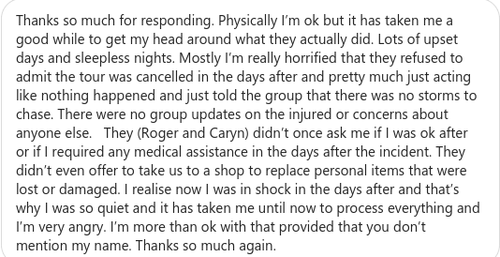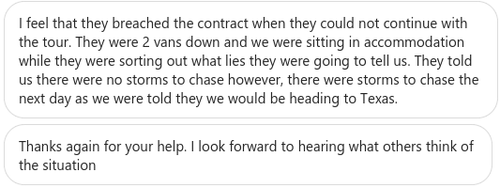I was recently contacted by one of the tour participants who was injured in this event. She is very concerned and wants help, but has asked me to not share her name. Based on her accounts, which I asked her to share in her own words, and the fact that she reached out to me specifically, I have no reason to disbelieve in anything that she shared.
From what I can gather, she is challenging that the tour group breached their contract when they ended the tour early after the incident on May 28th, 2019, when the tour was scheduled to continue through the 31st. Prior to the incident, she said they mentioned they were going to chase in Texas on the 29th, but after the incident, they changed their tune, saying that there were no more storms to chase for the rest of the tour.
She also shared some disturbing information that seems to solidify the case that SLT knowingly made poor decisions and tried to cover up what had really happened. Additionally, she says that the group has been unresponsive to her repeated attempts to follow up with them about the incident, during which she was injured (minor physical injuries, but much more significant psychological ones), had the tour ended early and some of her belongings were damaged or destroyed.
Unfortunately, based on the verbiage in the Tour Agreement that she passed along to me, I'm not sure that she a strong enough case to file any sort of dispute against SLT. This is where you all may come in, as I will share some direct quotes from her and see if anyone has any insight. I am not an attorney and I am not an expert with storm chase tours, so I told her I would reach out to some peers and see what we could come up with.
Since she does not live in the United States, this makes this situation even more difficult. In her perspective, she put a lot of trust and money into this tour, only to have it cut short after several in the tour were injured. It sounds like one individual was seriously injured. Below I will share direct quotes from her to better tell her side of the story. In addition to helping her out, I think some of what she said is very eye opening about how SLT operates, including a claim that they did not have any first aid kits on hand, despite claiming on their website that they did. Even I carry a first aid kit and I chase alone...






In my opinion, if SLT were to handle this incident in good faith, is it too much to ask that they at least offer a partial refund to the group, since the six day tour was cut in half? If that's too much to ask, why not at least be honest with them on the 29th and explain, that due to extreme circumstances, that they trip was going to be ended early and that they would do anything that they could to make up for this? It sounds like the tour just ended and the participants were left in limbo until they hired additional vehicles to transport the participants back to Denver. Also, if this was truly an accident, why would they ignore messages from participants who made major sacrifices and payments to join their tour? Even something as simple as "we're sorry about the incident and we are here to help you. Let us know what we might be able to do in order to resolve any concerns."
The more I hear, the more I am disturbed about this incident.
Why risk so many issues? I would be thoroughly embarrassed if I had a tour group and an incident like this happened. I would want to be as transparent as possible about what happened and try to be there for the participants who could have lost their lives. The only thing that silence does is lead to more suspicion that there was a cover-up.





